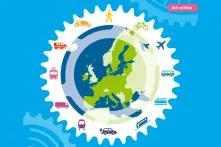
Unlike many industries, the manufacture of bicycles keeps on growing. This is mainly driven by the sale of e-bikes. The ever-increasing demand for them seems to be helping the industry to recover rapidly from the impact of Covid-19.

In 2015, commuters spent on average between 45 (Paris) and 101 (London) hours in congestion. Moreover, 70 percent of transport emissions derive from road transport. One alternative solution to these problems is the bicycle, a carbon-neutral and affordable transport alternative that can easily be combined with other transport modes.
The European bicycle industry (including pedal assist e-bike manufactures and the components and parts industry) is active in 23 out of 27 EU Member States. It consists of about 900 small and medium enterprises employing directly and indirectly 120,000 workers and investing more than one billion euros annually in research & development. This industry sells about 20 million bicycles annually. In the year 2019, sales of pedal assisted e-bikes (pedelecs) had reached 3.4 million. By 2030, the pedelec market is expected to grow to 13.5 million units sold annually, if favourable legislation can be upheld. This shows a tremendous growth of the bicycle industry, increasing from an annual turnover of around 5 billion euros 20 years ago, to nearly 14 billion euros in 2019.
In comparison, the European automotive industry sold 15.2 million passenger cars in 2018, out of which 150,000 were pure electric vehicles. Car production in the EU amounted to 16.1 million units in 2018. This shows that the number of pedelecs on the market far outweighs the number of e-cars; in Germany in 2018, even more e-cargo bikes than e-cars were sold.
The biggest trend in the bicycle industry in recent years has been the development and increasing uptake of pedelecs. They currently represent about 17 percent of EU bicycle sales, going up to 50 percent in some countries. Pedelecs have a promising potential to substitute motor vehicle usage over short journeys, while having all the benefits of conventional bicycles. A recent study shows that pedelec users move even more than traditional cyclists, which is mainly due to longer distances travelled by pedelec users. Other benefits of cycling are the efficiency, reliability and accessibility of bicycles due to their low purchase and maintenance costs, as well as the fact that bicycle usage is beneficial to a neighbourhood’s or community’s micro-economy as riders tend to frequent businesses and services located within a smaller radius from their homes. Moreover, the cost to construct and maintain quality bicycle paths is much lower than the cost of constructing new motor roads and/or widen existing ones.
The growth of the pedelec market also means more skilled jobs for the European bicycle industry, as four to five jobs are generated for the production of 1,000 pedelecs per year. In comparison, only two to three skilled workers are needed to produce 1,000 traditional bicycles per year. Closely linked to this are investments in large scale frame manufacturing in Europe, shortened supply chains and creating ‘Bicycle Valleys’ where bicycle assemblers and parts producers are all settled in one region.
The Covid-19 pandemic has also hugely affected the European bicycle industry. In March and April 2020, factories stopped or slowed down their production. This was necessary due to impacts on the supply chain, national guidance to stop all non-essential work as well as the need to adapt to increased safety and protective measures.
Reactions of national governments have differed widely. Some countries have implemented bailout funds and special unemployment benefits, companies in other countries are not able to benefit from such measures and have been forced to let some of their employees go.
In some of the most affected countries, a loss in turn-over in comparison to the year before is expected. In early summer, however, sales started to pick up again once lockdown measures were lifted, as cycling has been actively encouraged by government officials as a way to stay active whilst maintaining social distancing. To further promote cycling, special subsidy schemes have been implemented in some countries. Whether this increase in sales can be sustained is not yet clear, but a considerable part of the lockdown-induced losses recovered by the end of the year of 2020.
Sources for data and graphics: CONEBI; European Bicycle Industry & Market Profile 2019, https://bit.ly/2JbJsFK; European Automobile Manufacturers Association, Economic and Market Report, EU Automotive Industry Full-year 2018, https://bit.ly/34DJgr6; CONEBI; European Bicycle Industry & Market Profile 2019, https://bit.ly/2JbJsFK; Radmarkt, Destatis: Fahrrad-Einzelhandel kurbelt nach Shutdown aufwärts, https://bit.ly/34B0cy8


